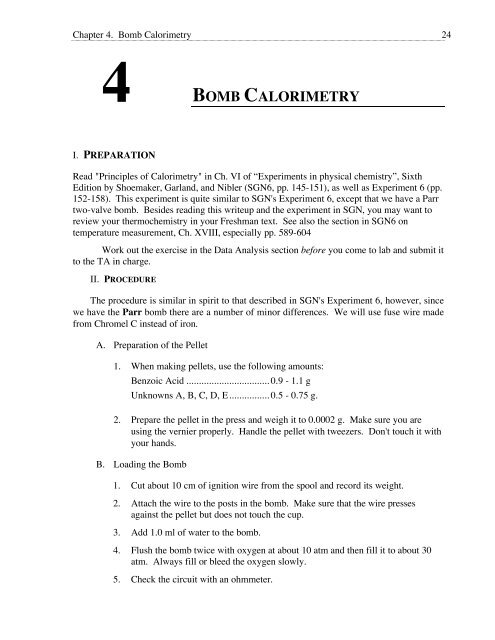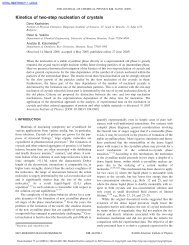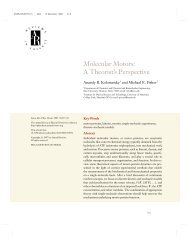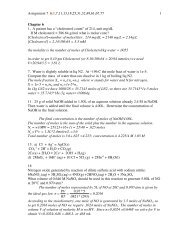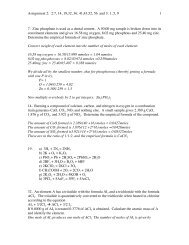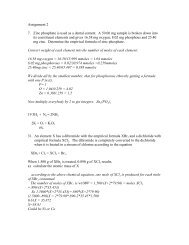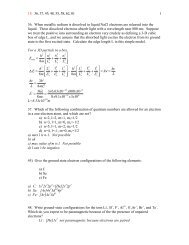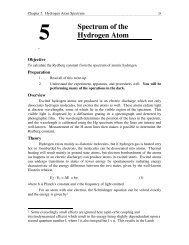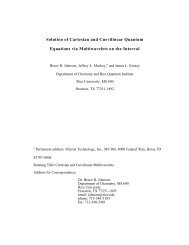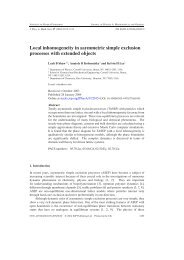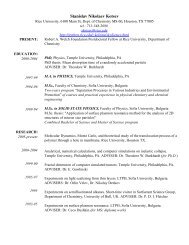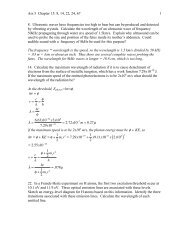BOMB CALORIMETRY - Python Home Page
BOMB CALORIMETRY - Python Home Page
BOMB CALORIMETRY - Python Home Page
Create successful ePaper yourself
Turn your PDF publications into a flip-book with our unique Google optimized e-Paper software.
Chapter 4. Bomb Calorimetry 24<br />
4<br />
<strong>BOMB</strong> <strong>CALORIMETRY</strong><br />
I. PREPARATION<br />
Read "Principles of Calorimetry" in Ch. VI of “Experiments in physical chemistry”, Sixth<br />
Edition by Shoemaker, Garland, and Nibler (SGN6, pp. 145-151), as well as Experiment 6 (pp.<br />
152-158). This experiment is quite similar to SGN's Experiment 6, except that we have a Parr<br />
two-valve bomb. Besides reading this writeup and the experiment in SGN, you may want to<br />
review your thermochemistry in your Freshman text. See also the section in SGN6 on<br />
temperature measurement, Ch. XVIII, especially pp. 589-604<br />
Work out the exercise in the Data Analysis section before you come to lab and submit it<br />
to the TA in charge.<br />
II. PROCEDURE<br />
The procedure is similar in spirit to that described in SGN's Experiment 6, however, since<br />
we have the Parr bomb there are a number of minor differences. We will use fuse wire made<br />
from Chromel C instead of iron.<br />
A. Preparation of the Pellet<br />
1. When making pellets, use the following amounts:<br />
Benzoic Acid ................................. 0.9 - 1.1 g<br />
Unknowns A, B, C, D, E ................ 0.5 - 0.75 g.<br />
2. Prepare the pellet in the press and weigh it to 0.0002 g. Make sure you are<br />
using the vernier properly. Handle the pellet with tweezers. Don't touch it with<br />
your hands.<br />
B. Loading the Bomb<br />
1. Cut about 10 cm of ignition wire from the spool and record its weight.<br />
2. Attach the wire to the posts in the bomb. Make sure that the wire presses<br />
against the pellet but does not touch the cup.<br />
3. Add 1.0 ml of water to the bomb.<br />
4. Flush the bomb twice with oxygen at about 10 atm and then fill it to about 30<br />
atm. Always fill or bleed the oxygen slowly.<br />
5. Check the circuit with an ohmmeter.
Chapter 4. Bomb Calorimetry 25<br />
C. The Calorimeter<br />
1. Place the bomb in the bucket, then fill the bucket with 2 l of water. The amount<br />
of water must be reproducible (so that the heat capacity of the calorimeter will<br />
be constant), but it is not necessary that it be exactly 2 l. We will use an<br />
automatic pipet manufactured by the Parr company which reproducibly delivers<br />
about 2 l of temperature-controlled water. You might want to measure the<br />
temperature to see if it is constant from run to run. Avoid dipping your hands in<br />
the water.<br />
2. Place the bucket in the calorimeter and connect the electrodes.<br />
3. Close the calorimeter, CAREFULLY lower the thermometer and the stirrer and<br />
start the motor. Be sure that the stirrer is not fouled by the wires.<br />
D. Adiabatic Jacket<br />
1. Bring the jacket temperature to the bucket temperature and maintain for about<br />
4-5 minutes, taking readings every 30 seconds until the temperature is constant<br />
or the temperature rise is linear. Read the thermometer as precisely as you can<br />
(to ca. 0.002 ˚C).<br />
2. Vibrate the thermometer, record the bucket temperature, and fire the bomb.<br />
3. Match the bucket and jacket temperatures as closely as possible. During the<br />
rapid temperature rise following the firing of the bomb, it may be difficult to<br />
make the jacket temperature track exactly with the bucket temperature. They<br />
should be kept as close as possible. During the leveling off period, you should<br />
be able to match the two temperatures to within the precision of your<br />
measurements.<br />
4. Once the temperature rise has slowed, begin taking readings from the bucket<br />
thermometer every 30 seconds. Continue to take readings until four successive<br />
readings yield the same result or the slope is linear. Record this final<br />
temperature.<br />
E. Unloading<br />
1. Stop the motor, CAREFULLY raise the thermometer and the stirrer and remove<br />
the bucket and bomb.<br />
2. Pour the water back into the reservoir and dry the bucket for the next run.<br />
3. Release the pressurized gas slowly from the bomb and then open the bomb.<br />
4. Carefully remove any unburned fuse wire, straighten it, measure its weight and<br />
record that figure.
Chapter 4. Bomb Calorimetry 26<br />
5. Rinse the bomb with water and dry it.<br />
IMPORTANT NOTES<br />
1. NEVER USE A WRENCH OF ANY SORT ON THE PARR <strong>BOMB</strong>!<br />
2. NEVER ALLOW THE MERCURY IN THE THERMOMETERS TO GET<br />
BELOW THE EXPANSION BULB, i.e., DO NOT LEAVE THE COLD<br />
WATER ON!<br />
3. IF THE <strong>BOMB</strong> LEAKS (emitting bubbles at a rate greater than 10 per minute),<br />
DO NOT FIRE!!..FIND OUT WHY IT LEAKS AND GET<br />
IT FIXED!<br />
4. The amount of water added to the bucket depends on temperature. Either use<br />
the same temperature (in the volumetric flask) or apply a correction in your<br />
calculations.<br />
5. If you are the last group to perform the experiment before an extended break<br />
(mid-semester, Spring, Summer, etc.) turn off the temperature controller/heater<br />
for the hot water bath and carefully remove the heater from the bath. This is<br />
necessary to deter corrosion of the apparatus by the water.<br />
6. Do at least three runs with benzoic acid and at least three runs with one<br />
unknown using the adiabatic calorimeter.<br />
III. DATA ANALYSIS<br />
The general equation of interest here is<br />
ΔE = C V<br />
ΔT.<br />
The benzoic acid runs will determine C V<br />
for the calorimeter and, this being known, the<br />
heats of combustion of the unknown can be calculated. The heat of combustion of the ignition<br />
wire will have to be taken into account also:<br />
C V<br />
=<br />
( ΔE BA<br />
∞ m ) + e<br />
ΔT<br />
where:<br />
m = weight of benzoic acid sample<br />
e = error due to wire burning = 1400 cal/g × mass of wire burned in g
Chapter 4. Bomb Calorimetry 27<br />
ΔT = temperature change, i.e., the difference between the corrected final and<br />
initial temperature readings<br />
ΔE BA<br />
= heat of combustion of benzoic acid = 6314.6 cal/g<br />
The same equation can be rewritten to get ΔE for the unknown:<br />
C V<br />
ΔT - e<br />
ΔE = m<br />
Exercise. Write a Matlab routine to analyze the calorimetric data in the Chem381<br />
Web site. Calculate the heat capacity of the bomb and ∆E for the unknown. Turn in<br />
your Matlab program, plots of Temperature vs time, and values of C V and ∆E. For this<br />
exercise it is not necessary to consider an analysis of the errors.<br />
IV. Written Report and Error Analysis<br />
You may find the discussion in SGN6, pp 10-24 useful in preparing your report.<br />
Introduction, Experimental, and Data: Except for complicated mathematical expressions<br />
your report must be typewritten. Your report should include a brief (~half-page) introduction,<br />
summarizing the theoretical background, and the objective and approach of the experiment. If<br />
the experimental method described in this writeup and in SGN was simply followed, so state,<br />
but be sure to mention any procedural changes. Include your raw data, preferably in tabular<br />
form.<br />
Results: Turn in your results together with sample calculations. They should be plainly<br />
marked and neatly arranged. The mean values you obtained for the heat of combustion of your<br />
unknown must be explicitly given together with your estimate of their uncertainty (below).<br />
Specify units for all numbers! Be sure to indicate which unknown was used. When you have<br />
completed your calculations, identify your unknown by comparing the heat of combustion you<br />
have obtained with those given in the table below.<br />
Discussion and Error Analysis:<br />
For this experiment a simplified error analysis will suffice. Estimate the uncertainty in C V<br />
and ΔE by calculating the standard deviation of the mean for each (SGN pp. 43-44). Since the<br />
value of ΔE for your unknown depends on your value of C V<br />
as well as on the calorimetric<br />
measurements with the unknown, the uncertainty in C V<br />
adds additional uncertainty to ΔE<br />
beyond that estimated from the standard deviation of the mean of ΔE. How much<br />
It is useful (but maybe somewhat discouraging!) to consider the accuracy you should have<br />
gotten. This determination relies only on temperature, weight, and volume measurements, and<br />
you can estimate how much the uncertainty in each affects the final answer. For example, you<br />
should be able to weigh to ±0.5 mg (and accuracy of ±0.1 is attainable). How much does this
Chapter 4. Bomb Calorimetry 28<br />
affect the final result What is the biggest source of error Discuss your results, identifying as<br />
best you can the most important sources of random and systematic errors, human, mechanical<br />
or otherwise.
Chapter 4. Bomb Calorimetry 29<br />
LIST OF POSSIBLE UNKNOWNS<br />
Compound<br />
ΔE, cal/g<br />
Menthol 9655.1<br />
Naphthalene 9616.9<br />
Anthracene 9541.0<br />
Phenanthrene 9496.7<br />
Benzophenone 8541.9<br />
β-Naphthol 8235.3<br />
o-Cresol 8133.7<br />
Benzil 7727.7<br />
Cinnamic acid methyl ester 7478.9<br />
Toluquinone 6577.1<br />
Hydoquinol 6209.2<br />
Formic acid methyl ester 3881.8<br />
Malonic acid 1991.2<br />
Mesotartaric acid 1838.9


